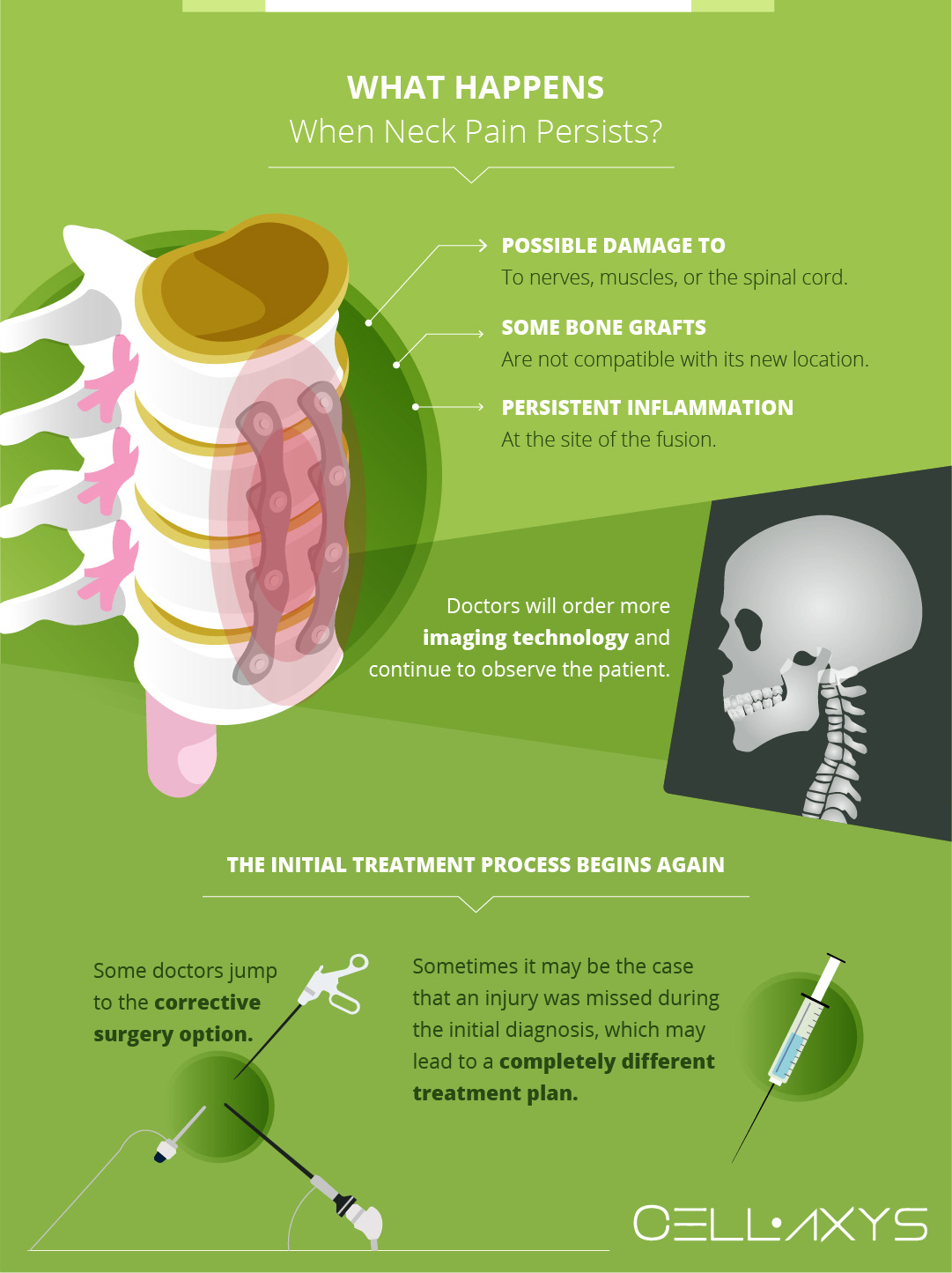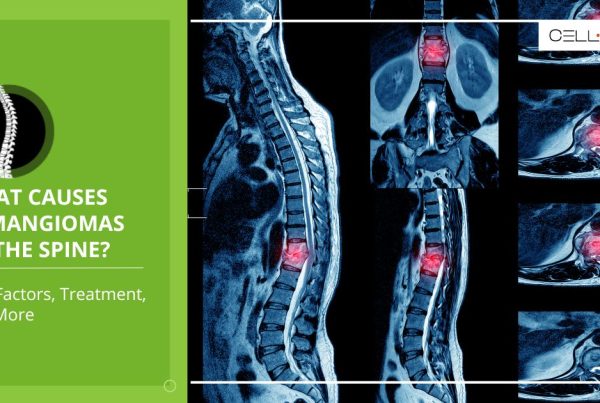Published on: March 13, 2020 | Updated on: February 3, 2025
Treatment for neck pain can take many forms. There are so many causes, and each requires a specific treatment plan. Ensuring a proper diagnosis is a good step, but sometimes, conventional methods fail to provide relief.
Persistent neck pain is often addressed with major cervical fusion surgery.
Despite the risks, many patients see positive results and can resume normal life after making a complete recovery.
However, it’s pertinent to note that not every patient needs surgical intervention. Many alternative treatments (which we’ll discuss) also offer hope to those who don’t wish to undergo surgery.
Today, we’ll talk about cervical fusion surgery. Many people still aren’t up for the idea for fear of problems that occur afterward.
Do you have Neck Pain?
Fill out the form below to schedule your FREE virtual consultation
What Happens During Neck Fusion?
The cervical spine contains seven vertebrae. Between each vertebra are discs that absorb shocks and stabilize the spine. Outside the spine are muscles, ligaments, tendons, and cartilage that provide a range of motion and support.
This intricate network surrounding the spine can be affected in many ways. Some common injuries/problems that may require a cervical fusion surgery include:
- Herniated Disc
- Arthritis
- Osteoporosis (complications from)
- Bone Spurs
- Bone Fracture
- Sudden Traumatic Injury
- Degenerative Disc Disease
There are many solutions for neck pain, so deciding which treatment option is right for each patient can be difficult. Often, neck pain goes away on its own, mainly due to minor injuries; they can heal without intervention.
But if pain persists and begins interfering with an individual’s ability to live a normal life, doctors look for the underlying cause of discomfort. Neck pain can be assessed using a physical evaluation, but most doctors will order a series of imaging techniques, such as an MRI or X-rays, to determine the source.
Diagnosing spinal abnormalities is very tricky. You cannot know the exact cause of the pain upfront. Many patients often have conditions like bone spurs, which can cause damage and discomfort, but they report no symptoms. Because of this, doctors have to be extra diligent about locating the exact source.
Issues in the neck that need fusion surgery relate to degenerative conditions such as arthritis and degenerative disc disease.
Neck fusion surgery, also called Anterior Cervical Fusion and Discectomy (ACDF), involves fusing two vertebrae to stabilize the spine or remove a disc. This procedure uses different methods, including discectomy, bone grafts, and metal cages.
However, only a surgeon and doctor can determine the best treatment plan for each patient.
Risks of Neck Fusion
Almost all surgeries have risks and potential complications. Cervical fusion is generally considered safe, but it is a major surgery.
Some common risks associated with spinal fusion include:
- Stroke
- Infection
- Blood Clots
- Rejection of a graft or other structures
- Complications with anesthesia
- Damage to structures in the neck
Patients can take steps to lower the chances of these complications. The risks should be discussed thoroughly with a doctor and surgeon before the procedure so that patients can be well-prepared if something goes wrong.
Aside from the risks of the surgery itself, other issues may arise after cervical fusion surgery. For example, the structure is particularly vulnerable during the procedure and the healing process. Vulnerability arises due to muscle weakness in the area (where the patient has already limited their movement due to the pain.)
Two things: Stiffness in the neck and a limited range of motion are the most common occurrences following cervical fusion surgery.
Problems After Cervical Fusion Surgery
Cervical fusion is a very common surgical procedure. It’s commonly performed to relieve chronic neck pain, nerve compression, or instability. Although it has the highest success rate (73%-83%), many patients have trouble returning to normal life years after surgery.
Let’s look at some problems that can arise after cervical fusion surgery.
Adjacent Segment Degeneration (ASD)
Cervical fusion can immobilize the vertebrae. At times, it puts a strain on one or more vertebrae or close segments, which can lead to pain, stiffness, or degeneration of the adjacent discs and joints.
Hardware Complications
The cervical fusion procedure involves using rods, screws, and plates to keep the spine in place. These components can get loose, break, or cause general discomfort over time, affecting mobility and leading to pain or infection.
Incomplete Fusion (Pseudoarthrosis)
At times, the surgery may be successful, but the bonds may not completely fuse, or the body may not heal the way it should. The condition is called pseudoarthrosis and can cause a lot of pain and instability over time, which may require another surgery.
Nerve Compression or Damage
Although the surgery is intended to relieve nerve pressure, scar tissue formation, or changes in the spine, it can sometimes worsen nerve compression, leading to numbness or a tingling sensation, which can cause weakness in the patient’s arms and hands.
Postural Changes and Muscle Imbalances
It can also alter the alignment of the spine, causing postural issues or muscle imbalances. This can further lead to chronic pain and tension in the neck and surrounding areas, such as shoulders and arms.
An important factor is that the surgery may not produce the intended results. Some patients have reported little to no relief from symptoms after a lengthy recovery period. When this is the case, doctors may suggest yet another corrective surgery. The recovery period for cervical fusion can be up to 18 months, so it’s no surprise that many individuals turn to alternative treatments for neck pain.
What Happens When Neck Pain Persists?

There are many reasons why patients may experience abnormal pain in the neck after surgery. There could be damage to nerves, muscles, or the spinal cord. Some bone grafts are not compatible (“fail”) in their new location. Persistent inflammation at the site of the fusion can impede the healing process. All of these and many more can go wrong while the body attempts to heal itself.
In an attempt to treat a patient’s condition, doctors will order more imaging technology and continue to observe the patient. The initial treatment process begins again, though some doctors jump to the corrective surgery option. It may be the case that an injury was missed during the initial diagnosis, which may lead to a completely different treatment plan.
Corrective surgery is often performed arthroscopically, using tiny cameras for guidance and tools for repair. An individual who is not interested in more surgery may consider alternative treatments for their pain.
Life After Cervical Fusion Surgery – Precautions and Restrictions
All patients need to know that while they can resume many of their life activities like before, some may be affected, like swallowing. You won’t be able to swallow for a couple of days after the surgery, as there will likely be some swelling.
It is a short-term effect and doesn’t last long. Some other problems that can occur after the surgery include:
Neck Mobility issues
The surgery involves fusing two vertebrae in the neck; at times, patients can lose their spinal flexibility permanently. They may not be able to turn their heads to the side, and some forward motion may also be lost. So, generally, keep a margin of about 5 to 10% where the bending level of the spine fused will not be the same.
In many cases, flexibility may already be lost due to the pain of degenerative disc disease. It’s less about the surgery and more about the fact that most of the mobility may already be lost, and the patient may not have noticed it because, due to the pain, they self-limit their neck movements.
Life Activities
Patients worry about whether they can drive or do normal activities after the surgery. Now, if you are given a neck collar to wear after the surgery, you may not be able to drive until your doctor gives you a clear. Otherwise, there is no impact on driving.
In fact, there are very few permanent restrictions on activities or work following the surgery. For instance, sports may be limited for kids, but adults will be allowed to snowboard, drive, and work, in fact, do everything they used to before the surgery.
Doctors may, however, recommend going easy on yourself with extreme sports like mountain biking or back-country skiing.
Weight or Heavy Lifting
After the surgery, patients are instructed not to lift anything heavier than a gallon of milk until the fusion has completely healed. They should also avoid straining themselves, as this could lead to the cauterized vessel opening up.
They should rest and allow the fusion to heal completely naturally. Then, they can return to their weight-lifting routine.
However, heavy weight lifting exercises like squats and clean jerks should still be avoided.
Using the Phone
One common restriction after the surgery is limiting the patient’s phone and computer time. If the patient has to bend their neck forward to view the screen, it will further strain the fusion.
The head normally weighs 5 to 6.3 kilograms. When looking up straight, the weight is evenly balanced, but as you bend forward, it weighs up to three times more and puts a lot of pressure on the interior part of the neck.
It increases the risk of follow-up surgeries if you weigh your neck down. In fact, bending for longer hours is one of the main reasons that cervical fusion surgery is needed in the first place.
Non-Operative Treatments to Avoid Neck Fusion Surgery
The emerging scientific field of regenerative medicine, Orthobiologics, seeks to address injury without resorting to more invasive methods. Using a patient’s own regenerative cells and the body’s healing components, doctors can pinpoint the location of an injury and transplant a concentrated solution of these cells to boost the natural healing process.
CELLAXYS offers two types of regenerative therapy: autologous stem cell therapy and platelet-rich plasma (PRP) therapy. Both platelets and stem cells are used in the body’s natural healing process to call to other cells and regenerate dead or damaged cells.
These therapies have shown promising results for many conditions, including spine therapies. Regenerative therapies can heal structures such as muscle, tendons, bone, and cartilage.
Patients with chronic pain may seek these treatments as an alternative to surgery, often with promising results. They may also benefit patients who have already undergone surgery. By increasing the number of healing cells in an injury, especially post-operation, the body can heal faster and better than it would without regenerative therapy.
Sources
Footnotes
- Gruskay JA, Webb ML, Grauer JN. Methods of evaluating lumbar and cervical fusion. The Spine Journal. 2014;14(3):531-9.
- Winegar CD, Lawrence JP, Friel BC, Fernandez C, Hong J, Maltenfort M, Anderson PA, Vaccaro AR. A systematic review of occipital cervical fusion: techniques and outcomes: a review. Journal of Neurosurgery: Spine. 2010;13(1):5-16.
- Perry J, Nickel VL. Total cervical-spine fusion for neck paralysis. JBJS. 1959;41(1):37-60.
- Hoy D, Protani M, De R, Buchbinder R. The epidemiology of neck pain. Best practice & research Clinical rheumatology. 2010;24(6):783-92.
- Tew Jr JM, Mayfield FH. Complications of surgery of the anterior cervical spine. Neurosurgery. 1976;23:424-34.
References
- Cervical Disc Surgery: Disc Replacement or Fusion?. WebMD. Accessed 9/5/2023.
- A more than 20-year follow-up of pain and disability after anterior cervical decompression and fusion surgery for degenerative disc disease and comparisons between two surgical techniques. BMC Musculoskeletal Disorders. Accessed 9/5/2023.
- Anterior Cervical Discectomy and Fusion Complications. Spine-Health. Accessed 9/5/2023.
CELLAXYS does not offer Stem Cell Therapy as a cure for any medical condition. No statements or treatments presented by Cellaxys have been evaluated or approved by the Food and Drug Administration (FDA). This site contains no medical advice. All statements and opinions are provided for educational and informational purposes only.
Dr Pouya Mohajer
Author
Pouya Mohajer, M.D. is the Director of Spine and Interventional Medicine for CELLAXYS: Age, Regenerative, and Interventional Medicine Centers. He has over 20 years of experience in pain management, perioperative medicine, and anesthesiology. Dr. Mohajer founded and is the Medical Director of Southern Nevada Pain Specialists and PRIMMED Clinics. He has dedicated his career to surgical innovation and scientific advancement. More about the doctor on this page.
Dr Pejman Bady
Contributor
Dr. Pejman Bady began his career over 20 years ago in Family/Emergency Medicine, working in fast-paced emergency departments in Nevada and Kansas. He has served the people of Las Vegas as a physician for over two decades. Throughout this time, he has been met with much acclaim and is now the head of Emergency Medical Services in Nye County, Nevada. More about the doctor on this page.









